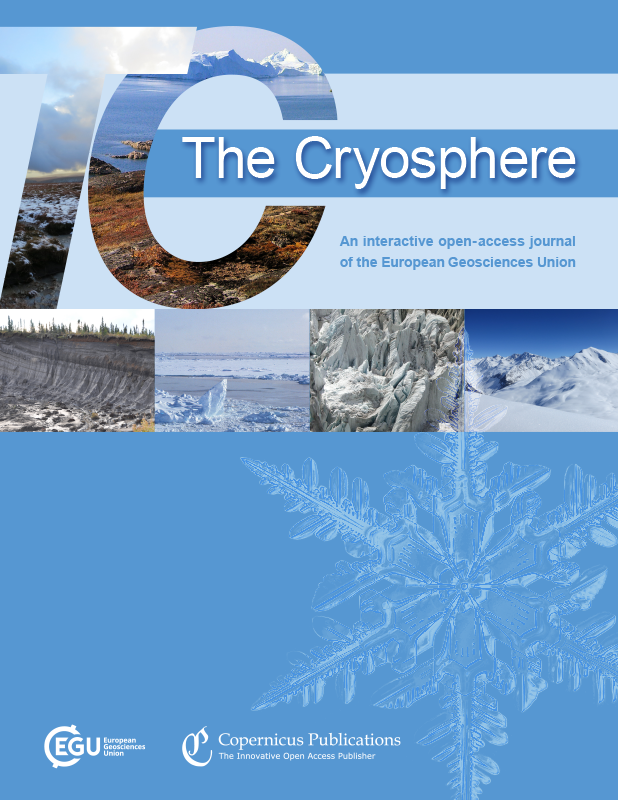利用机载激光扫描数据评估ICESat-2反演的雪深
IF 4.4
2区 地球科学
Q1 GEOGRAPHY, PHYSICAL
引用次数: 3
摘要
摘要美国国家航空航天局ICESat-2任务的卫星激光测高数据具有前所未有的精度,高分辨率高程数据集的可用性不断增加,为测量山区积雪深度提供了新的机会,而山区积雪深度是生态系统和水资源监测的关键变量。我们通过对ICESat-2 ATL06海拔雪和各种非数字海拔模型的差异,对Tuolumne盆地上游(美国加利福尼亚州)的雪深进行了3年的测量。仅从ATL06数据得出的雪深(雪开和雪关)提供了较差的时间和空间覆盖,限制了其潜在效用。然而,使用来自机载激光雷达测量的数字地形模型作为雪偏离高程源,得出的雪深度精度为~ 0.2 m(偏置)和~的精度 1. m(随机误差),精度提高了0.5 m用于低边坡(< 10∘),与八张参考机载激光雷达雪深图相比。ICESat-2ATL06和卫星摄影测量数字高程模型得出的雪深偏差较大,精度降低,部分原因是受影响区域的误差增加。ICESat-2雪面高程的重复测量与卫星或机载产品的各种组合,将有助于在雪深观测有限的山区绘制雪深地图和估计水资源可用性。本文章由计算机程序翻译,如有差异,请以英文原文为准。
Evaluation of snow depth retrievals from ICESat-2 using airborne laser-scanning data
Abstract. The unprecedented precision of satellite laser altimetry data from the NASA ICESat-2 mission and the increasing availability of high-resolution
elevation datasets open new opportunities to measure snow depth in mountains, a critical variable for ecosystem and water resource monitoring. We
retrieved snow depth over the upper Tuolumne basin (California, USA) for 3 years by differencing ICESat-2 ATL06 snow-on elevations and various
snow-off digital elevation models. Snow depth derived from ATL06 data only (snow-on and snow-off) offers a poor temporal and spatial coverage,
limiting its potential utility. However, using a digital terrain model from airborne lidar surveys as the snow-off elevation source yielded a snow depth
accuracy of ∼ 0.2 m (bias) and precision of ∼ 1 m (random error) across the basin, with an improved precision
of 0.5 m for low slopes (< 10∘), compared to eight reference airborne lidar snow depth maps. Snow depths derived from ICESat-2
ATL06 and a satellite photogrammetry digital elevation model have a larger bias and reduced precision, partly induced by increased errors in
forested areas. These various combinations of repeated ICESat-2 snow surface elevation measurements with satellite or airborne products will enable
tailored approaches to map snow depth and estimate water resource availability in mountainous areas with limited snow depth observations.
求助全文
通过发布文献求助,成功后即可免费获取论文全文。
去求助
来源期刊

Cryosphere
GEOGRAPHY, PHYSICAL-GEOSCIENCES, MULTIDISCIPLINARY
CiteScore
8.70
自引率
17.30%
发文量
240
审稿时长
4-8 weeks
期刊介绍:
The Cryosphere (TC) is a not-for-profit international scientific journal dedicated to the publication and discussion of research articles, short communications, and review papers on all aspects of frozen water and ground on Earth and on other planetary bodies.
The main subject areas are the following:
ice sheets and glaciers;
planetary ice bodies;
permafrost and seasonally frozen ground;
seasonal snow cover;
sea ice;
river and lake ice;
remote sensing, numerical modelling, in situ and laboratory studies of the above and including studies of the interaction of the cryosphere with the rest of the climate system.
 求助内容:
求助内容: 应助结果提醒方式:
应助结果提醒方式:


